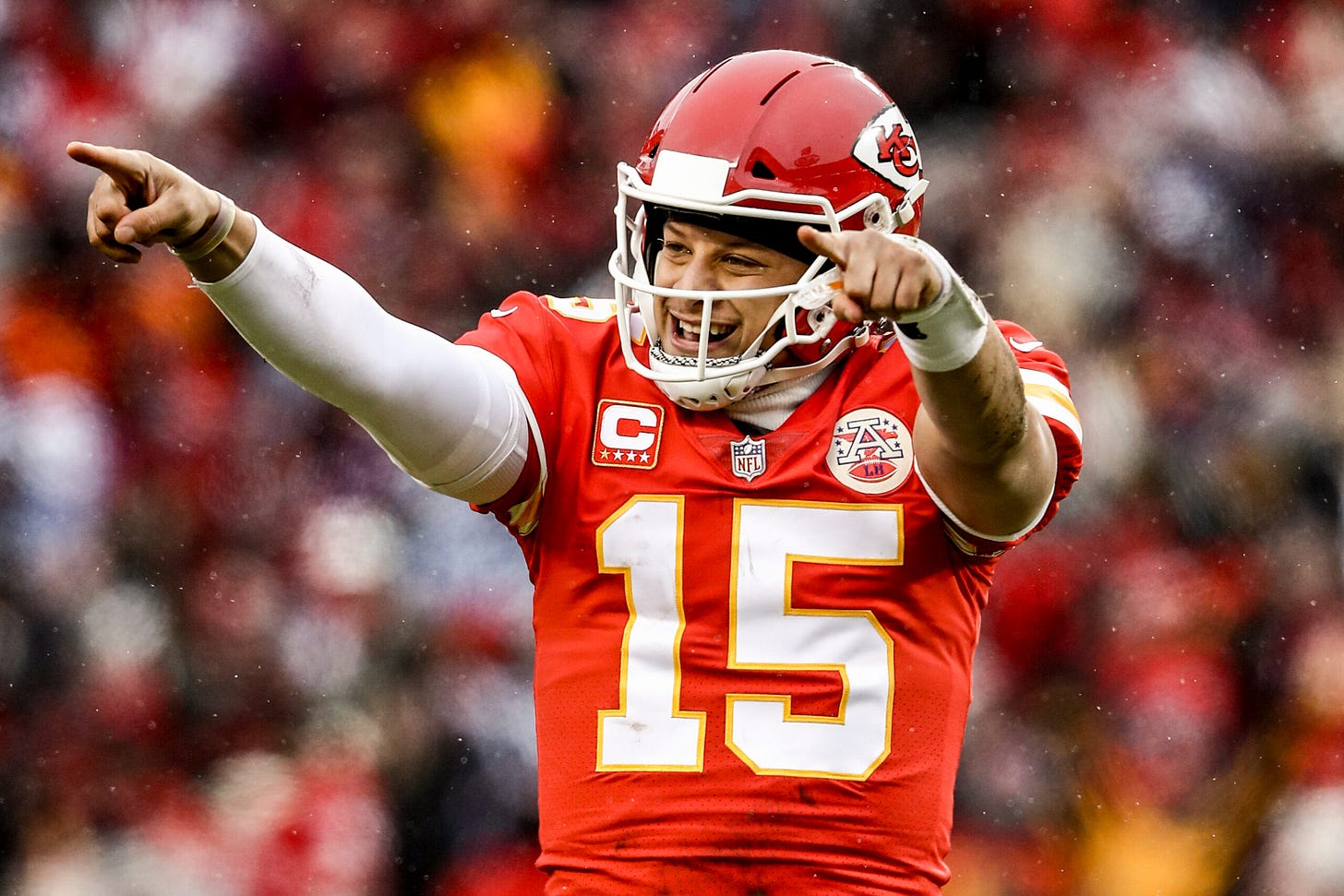This Is How Patrick Mahomes Works His Magic
His mechanics are different from everyone else in the league.
Update: Patrick Mahomes has now won his second league MVP award.
The NFL consensus on how Patrick Mahomes does what he does is simple: Magic. As Philadelphia Eagles cornerback Darius Slay put it on his podcast ahead of Sunday’s Super Bowl, “The man is a magician.”
But Mahomes isn’t magic. There’s a very specific reason the 27-year-old quarterback is able to do what he has done. And it hides in plain sight.

Patrick Mahomes whips an off-balance throw to a receiver. (Wikimedia Creative Commons)
Mahomes played the AFC Championship Game with a sprained right ankle, on the same leg he pushes off with when he winds up to throw.
He finished the day with 326 yards, two touchdowns and a 67 percent completion rate on over 40 attempts, but by the second quarter it was clear he was hobbled. He was moving slower, less fluid than we’re used to seeing him, but more than anything it was clear that he couldn’t really push off his injured back foot.
Mahomes’s performance showed his grit, but also something else: That Patrick Mahomes doesn’t need his lower half to throw the ball effectively.
Ten or fifteen years ago, the way that Patrick Mahomes throws the football would have been regarded as bad quarterback mechanics.
Until relatively recently, quarterbacks were taught to use similar mechanics to those we saw out of guys like Roger Staubach and Johnny Unitas. It was a stiff and linear approach to throwing the football.
If you watch the older generation of quarterbacks who played in this millennium—Brady, Brees, Manning—you’ll see a lot of those older mechanics in play.

Former Saints QB Drew Brees heaves one deep, showcasing the old-guard, linear approach to throwing. (Wikimedia Creative Commons)
But the game has changed quite a bit in the last decade, and so has the way quarterbacks throw the football. The new mechanics are all about generating torque to provide power to the throw. You don’t see high level quarterbacks taking big wind up steps with their front foot anymore, because that’s not where their power comes from. There is still weight transfer involved, but much more focus is put on driving the hips open as you throw, similar to swinging a baseball bat. Power is derived primarily from the torque that the rotation of the hips, trunk, and shoulders give—and less so from the drive off the back foot. This is why you see guys like Dak Prescott practicing their sambain pregame warmups.
Modern quarterbacks still need their legs to throw the ball. A solid base helps generate the necessary ground force to violently drive the hips open. Even more important: It helps with timing.
The technical term for this is kinematic sequencing and it’s most often thought about as a specialized area of study for baseball pitchers but it’s something quarterbacks pay a lot of attention to now as well. Think of it as the biomechanical laws of throwing. The short version is that there is a correct sequence of body movements when it comes to throwing something and all throws should start from the bottom. If your lower half is off, then your upper half will follow, and the throw won’t be on target.
Nearly all quarterbacks in the NFL rely on kinematic sequencing. Every throw they make is reliant on how correctly positioned their lower half is. This is why you’ll see guys with arms as strong as Joe Burrow and Josh Allen deliberately set their feet even when they’re throwing short bubble screens straight to the sideline. It’s a built-in part of their throwing mechanics. Even when throwing on the run, quarterbacks have a specific position they want their feet and body to be in when they throw the ball. Even if the play is off script and they’re scrambling.
Sometimes you’ll hear commentators say that Patrick Mahomes looks smoother on the field than everyone else. And this is true. But it’s not because Mahomes is calmer than everyone else or having more fun.
It’s because the biomechanical laws that bind other quarterbacks do not apply to Patrick Mahomes. He doesn’t need his feet set to throw deep balls. He doesn’t need a balanced lower half. He doesn’t even really need proper kinematic sequencing in order to throw a good ball..
That’s because Mahomes is able to produce incredible amounts of torque just with his hips and upper body. The reason, according to Bobby Stroupe, Mahomes’ trainer, is because of Mahomes’ unique body type.
“He has the most athletic spine I’ve ever seen.”
Spine strength and flexibility allow Mahomes to make up for the ground force lost by not having a solid base. And not needing a solid base opens up Mahomes’ game to more creativity than we’re used to seeing at the quarterback position. It allows him to throw balls downfield from body positions that would be impossible for other quarterbacks.
When you couple this bizarre spinal flexibility with insane arm strength and preternatural touch, you get the baffling acrobatics and improvisation that Mahomes displays every Sunday.

And also: The freedom to abandon a solid base gives him openings to escape from seemingly inescapable situations. In the 2022 regular season, no passer was hurried more than Mahomes (58 hurries). Yet he took fewer sacks than all but two 17-game starters in the NFL. His mobility plays a big role here, sure. But frequently on these hurried plays, Mahomes taps into his “magic” to get off throws when anyone else would’ve thrown the ball away or taken the sack.
It’s this ability to throw without leveraging his mechanics from the base that sets Mahomes apart.


